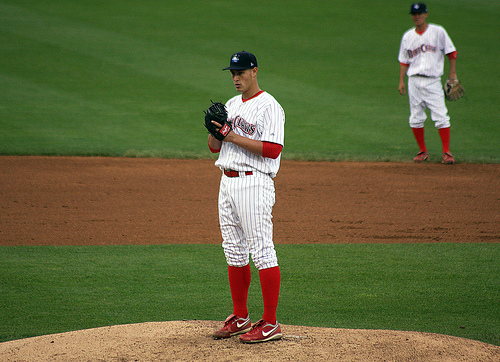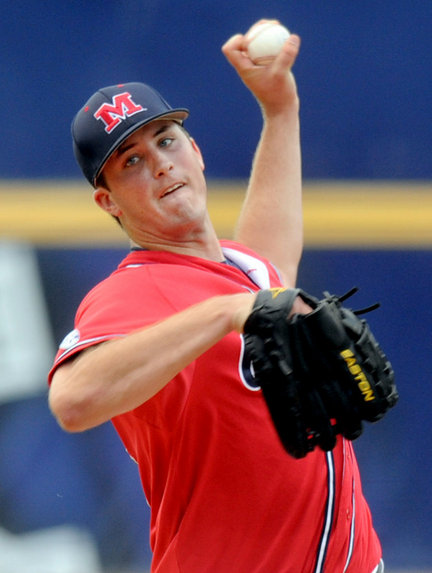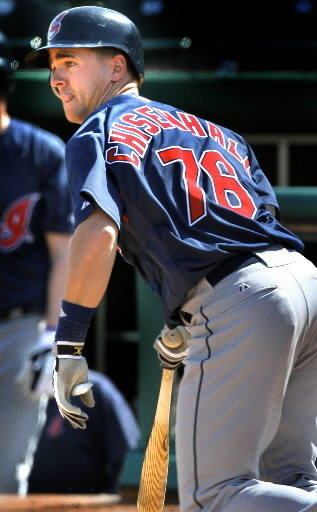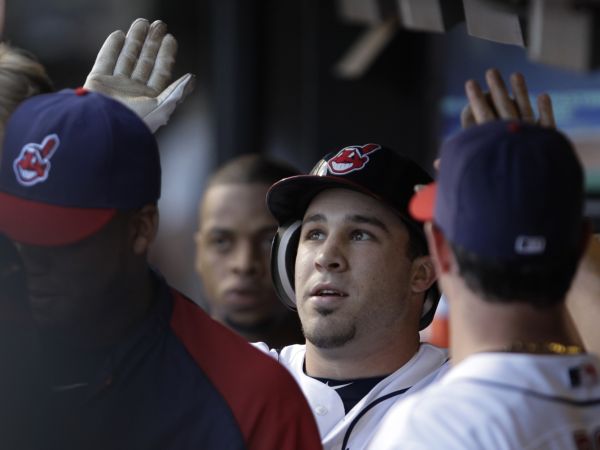 Indians Archive
Indians Archive  Cleveland Indians Top 50 Prospects: 1-5
Cleveland Indians Top 50 Prospects: 1-5
 Well, we finally made it. The long odyssey has reached its climax. I’m about to finally unveil my top five prospects in the Cleveland Indians organization. The pinnacle of the farm system includes four players drafted by the Indians, and one player acquired by trade. Two infielders, two righthanded pitchers and a southpaw. If you know anything at all about the team and have been following along with our countdown, you probably have a pretty good idea who the five players are. Ah, but what order are they in? That’s the big question at this point. Well, you’re about to find out.
Well, we finally made it. The long odyssey has reached its climax. I’m about to finally unveil my top five prospects in the Cleveland Indians organization. The pinnacle of the farm system includes four players drafted by the Indians, and one player acquired by trade. Two infielders, two righthanded pitchers and a southpaw. If you know anything at all about the team and have been following along with our countdown, you probably have a pretty good idea who the five players are. Ah, but what order are they in? That’s the big question at this point. Well, you’re about to find out.
I hope you’ll use our little list here as a guide when you check out the farm teams in the area throughout the year, and keep an eye out for how these players progress throughout the season. As we all know, the Indians are not going to build a winner through free agency. They are going to have to build a winner through solid drafting, shrewd trades, scouting and prospect development. So catch a Captains, Aeros, and Clippers game at some point this season and take a look at the future of the organization. The tickets are cheaper, the beer is just as cold and the hot dogs are just as good. Again, I hope you enjoyed reading this list as much as I enjoyed writing it. Now if you'll excuse me, I'm off to plan my trip to Goodyear!
As always, if you missed any of our prior installments of the countdown, here's a link to prospects #6-10, #11-15, #16-20, #21-30, #31-40 and #41-50.
5. Alex White, RHP
DOB: 8/29/1988
Height/Weight: 6-3/200
Bats/Throws: R/R
Acquired: 1st round pick in 2009
2010 Stats: 10-10, 2.45 ERA, 117 K and 46 BB in 150 2/3 IP between A and AA.
 Scouting report: White was the Indians first pick in the 2009 draft out of North Carolina, where he anchored the staff for one of the better teams in college baseball. White actually faced fellow 2009 draft pick Jason Kipnis in the 2009 College World Series when his Tar Heels played Kipnis’ Sun Devil squad. White throws a fastball that sits comfortably in the low 90s and he can reach back for a little extra to touch the mid 90s. The pitch has natural sink to it, somewhat comparable to Fausto Carmona’s 2-seamer. It’s a heavy pitch, and creates lots of swings and misses as well as groundballs. His best secondary offering is a splitter that is slower than the fastball but has very hard down action. He threw a slider in high school, but got away from it in college in favor of the splitter. He’s bringing back the slider so he can have three pitches and remain in the starting rotation.
Scouting report: White was the Indians first pick in the 2009 draft out of North Carolina, where he anchored the staff for one of the better teams in college baseball. White actually faced fellow 2009 draft pick Jason Kipnis in the 2009 College World Series when his Tar Heels played Kipnis’ Sun Devil squad. White throws a fastball that sits comfortably in the low 90s and he can reach back for a little extra to touch the mid 90s. The pitch has natural sink to it, somewhat comparable to Fausto Carmona’s 2-seamer. It’s a heavy pitch, and creates lots of swings and misses as well as groundballs. His best secondary offering is a splitter that is slower than the fastball but has very hard down action. He threw a slider in high school, but got away from it in college in favor of the splitter. He’s bringing back the slider so he can have three pitches and remain in the starting rotation.
White signed at the deadline in 2009, and after a long college season the Indians held off on having him make his pro debut until 2010 when he began the season close to home in high A Kinston. He made a couple of appearances with the big league club in spring training out of the bullpen, but was quickly sent down to minor league camp to begin his career as a starter. Pitching in front of plenty of friends and family, White did not disappoint in the Carolina League. White went 2-3 with a 2.86 ERA and a 41/14 K/BB ratio in his 44 innings pitched for Kinston.
After his success in A ball, the Indians moved White up to AA Akron, but with a catch. They wanted him to completely stop throwing his splitter and work solely on developing his slider. He had started throwing the slider in Kinston, and while he was becoming more and more comfortable with the pitch, it wasn’t at the point where it was even an average offering. White took the request in stride, and abandoned his best secondary pitch in favor of one that he hadn’t thrown consistently in years. While his strikeout ratio dropped in Akron, so did his ERA. He threw 106 2/3 innings for Akron, posting a 2.28 ERA and a 76/27 K/BB rate. Some scouts are citing the lower K rate in AA as an indication that White will have trouble missing bats at higher levels. I think it was a product of not using his splitter, and expect his K/9 rate to be back up in 2011. ESPN's Keith Law in particular has been adamant that he sees White as a reliever because he only has two pitches and struggled to miss bats in AA.
Expect White to start 2011 at AAA Columbus in the rotation. He likely would have been added to the Columbus roster for the AAA playoffs, but the Indians had him on a 150 innings limit that he hit while in Akron. If he pitches well in the first half of the year, then we could see White in Cleveland at some point in 2011. He will be back to throwing all three of his pitches this year, and has a chance to be part of a young Cleveland rotation even before rosters expand in September.
Glass half-full: White’s slider becomes a weapon, and he becomes a consistent #2/3 starter.
Glass half-empty: White can’t develop a quality 3rd pitch and is relegated to a power bullpen arm.
4. Jason Knapp, RHP
DOB: 8/31/1990
Height/Weight: 6-5/235
Bats/Throws: R/R
Acquired: Part of the Cliff Lee deal in 2009; 2nd round draft pick of the Phillies in 2008
2010 Stats: 1-2, 2.86 ERA, 47 K and 12 BB in 28 1/3 IP between the AZL Indians and low A
Scouting report: Knapp is big, young and immensely talented. He throws as hard as anyone in the organization, with his fastball sitting in the mid 90’s and touching triple digits in the past. He has been able to blow away hitters in the low minors, racking up 208 K’s in 156 1/3 IP for his career.
touching triple digits in the past. He has been able to blow away hitters in the low minors, racking up 208 K’s in 156 1/3 IP for his career.
The problem is not his talent, it is his injury history and mechanics. When he came over to the Indians in the Cliff Lee deal, his mechanics were a mess. His front side was flying open, his arm was dragging behind his body and he was throwing across his body. The Indians started to clean up his delivery, but he had elbow problems and missed the remainder of 2009 and most of 2010 after undergoing surgery to clean up "loose bodies" in his elbow. When he came back in 2010, Knapp was on a restricted pitch count to ensure that no unnecessary strain was placed on his arm. He blew away hitters in the complex leagues, then went on and pitched for the Midwest League champion Captains down the stretch and in the playoffs. All told, Knapp posted a 2.86 ERA and struck out 47 in 28 1/3 innings pitched in 2010.
The great debate about Knapp is whether he is a front of the rotation starter or a power reliever. Many scouts see him as a closer down the line. I still think he can start, which is why I have him as high as I do on this list. He has as much talent as anyone in the Indians system. If he can continue to refine and clean up his mechanics and become more of a pitcher than a thrower, Knapp could be the #1 in the Indians rotation someday. But that’s a long way off, and I’ll be happy if Knapp gets through 2011 healthy. Look for him to begin the season at high A Kinston with the potential to move to Akron around the all star break if he is healthy. He's still just 20, and the Indians are going to be cautious with his million-dollar arm.
Glass half-full: A #1 starter who strikes out 250+ a season with an ERA under 3.00
Glass half-empty: Injured and out of baseball.
3. Drew Pomeranz, LHP
DOB: 11/22/1988
Height/Weight: 6-5/235
Bats/throws: R/L
Acquired: 1st round pick in 2010
2010 Stats: Signed late, did not play in 2010
 Scouting report: Pomeranz is a big, strong lefthanded pitcher who attacks hitters with a plus fastball and a curveball that, when he can control it, is one of the best secondary pitches in the 2010 draft. It drops off the table at a hard 12-6 angle, and college players had fits trying to hit it. His fastball sits comfortably in the low-90s, and he can reach back for a little extra and touch the high 90s. He’s going to rack up the strikeouts, but also expect him to rack up some walks as his curveball command can sometime abandon him. He also throws a changeup, but it was more of a “show me” pitch in college and will have to be refined in the pros. He’s going to have a lot of high pitch counts, but has shown the ability to maintain his stuff into the late innings. He's a very confident pitcher who trusts his stuff and loves to attack hitters.
Scouting report: Pomeranz is a big, strong lefthanded pitcher who attacks hitters with a plus fastball and a curveball that, when he can control it, is one of the best secondary pitches in the 2010 draft. It drops off the table at a hard 12-6 angle, and college players had fits trying to hit it. His fastball sits comfortably in the low-90s, and he can reach back for a little extra and touch the high 90s. He’s going to rack up the strikeouts, but also expect him to rack up some walks as his curveball command can sometime abandon him. He also throws a changeup, but it was more of a “show me” pitch in college and will have to be refined in the pros. He’s going to have a lot of high pitch counts, but has shown the ability to maintain his stuff into the late innings. He's a very confident pitcher who trusts his stuff and loves to attack hitters.
His best pitch is his curveball, and while it has been described by most scouts as a “knuckle curve.". You can see him getting ready to deliver the pitch in the photo to the left. Pomeranz was recently interviewed by Baseball Prospectus, and here’s what he had to say about the pitch:
"It’s hard to explain. I literally just hold it like… a lot of people spike it and still throw it like a normal curveball and break their wrist. I hold it like a spike. I hook my middle finger on a seam, and my thumb on one of the seams, and I push off the top of the seam, holding it kind of like a two-seam, but turned out to the front. My fingers that are on the top are like two legs that are crossing, and I just pretty much flick it straight forward, no wrist-breaking action or anything, I just flick it straight forward and kind of hold it with the middle finger and thumb, and flick with my pointer finger."
Pomeranz had a good start to his senior season last year, but struggled with his control late and some scouts were projecting he would fall out of the top 10 in the draft. But he was seen as the top collegiate pitcher in the draft for much of 2010, and he was the first collegiate pitcher selected when the Indians took him #5 overall.
Pomeranz should open 2011 at High-A Kinston on the Alex White career path. He’s polished enough to pitch his way to AA, but expect him to be up against his innings limit in early September and shut down for the season regardless of how he is pitching.
Glass half-full: He refines his delivery and command and becomes a 1/2 guy at the front of the rotation for years to come.
Glass half-empty: He struggles with his command and becomes Andrew Miller.
2. Lonnie Chisenhall, 3B
DOB: 10/04/1988
Height/Weight: 6-1/200
Bats/throws: L/R
Acquired: 1st round pick in 2008
2010 Stats: .278/.351/.450 at AA Akron, with 17 HR and 84 RBI
Scouting report: Chisenhall was a shortstop in college, and like Jason Kipnis he stuck at his original position for short-season Mahoning Valley in his professional debut. Also like Kipnis, the Indians moved him to his long-term position for his first full season in Kinston. After some initial struggles at the hot corner, Chisenhall has evolved into a solid 3B with room to get better. He has soft hands and a strong arm, and should be an above-average MLB third baseman before it's all said and done. As we all know, 3B in Cleveland is wide open at the start of 2011, and whoever gets the job out of spring training is just keeping it warm until Chisenhall is deemed ready.
debut. Also like Kipnis, the Indians moved him to his long-term position for his first full season in Kinston. After some initial struggles at the hot corner, Chisenhall has evolved into a solid 3B with room to get better. He has soft hands and a strong arm, and should be an above-average MLB third baseman before it's all said and done. As we all know, 3B in Cleveland is wide open at the start of 2011, and whoever gets the job out of spring training is just keeping it warm until Chisenhall is deemed ready.
His swing is described by scouts with superlatives like “sweet,” “pretty,” and “a thing of beauty.” He has good gap-power, and projects to hit between 20 and 30 home runs in the big leagues. Chizz dealt with some injury issues in 2010, and those power numbers look even better when you consider they were accomplished in just 460 at bats and with wrist problems. Chisenhall doesn’t have a superstar level ceiling. No one thinks he’s going to be the next Evan Longoria. But he also has an awfully high floor, as barring injury he should hit enough to be a productive major-leaguer. If there is one think he needs to work on, it is hitting left handed pitching, as he still produced some pretty noticeable splits last year against southpaws. The more he faces lefties as a professional the better he will get, and I don’t think that his struggles are anything serious enough to hold him back from being a productive major league hitter.
Chizz should start 2011 in AAA Columbus, with an excellent chance to join Jason Kipnis in the Cleveland infield before all is said and done. By 2012, he should be a mainstay in the Cleveland lineup.
Glass half-full: .290/.365/.450, with above-average defense to boot. I’ve long compared him to Travis Fryman without the gold gloves.
Glass half-empty: .250/.340/.380, still with good defense. Brook Jacoby without the nostalgia.
1. Jason Kipnis, 2B
DOB: 04/03/1987
Height/Weight: 5-10/175
Bats/throws: L/R
Acquired: 2nd round pick in 2009
2010 Stats: .307/.386/.492 between A+ and AA, with 16 HR and 76 RBI
 Scouting report: Drafted as an OF out of Arizona State, the Indians decided that a move to 2B would maximize his value as long as he could handle the switch defensively. Kipnis played OF in 2009 in Mahoning Valley and was moved to 2B full-time last year in Kinston. By all accounts, Kipnis has handled the transition well, and profiles to be at least league average defensively at 2B. So while he will never be Robbie Alomar, he isn’t going to be Carlos Baerga either. He's still having a little trouble with his double-play turn, but he's a good athlete and it's nothing more reps won't fix. OF to 2B is quite a transition, one that the #2 overall pick in the 2009 draft Dustin Ackley is having trouble with. Scouts see Kipnis as much more likely to stick at 2B than Ackley.
Scouting report: Drafted as an OF out of Arizona State, the Indians decided that a move to 2B would maximize his value as long as he could handle the switch defensively. Kipnis played OF in 2009 in Mahoning Valley and was moved to 2B full-time last year in Kinston. By all accounts, Kipnis has handled the transition well, and profiles to be at least league average defensively at 2B. So while he will never be Robbie Alomar, he isn’t going to be Carlos Baerga either. He's still having a little trouble with his double-play turn, but he's a good athlete and it's nothing more reps won't fix. OF to 2B is quite a transition, one that the #2 overall pick in the 2009 draft Dustin Ackley is having trouble with. Scouts see Kipnis as much more likely to stick at 2B than Ackley.
League-average at 2B should be plenty for Kipnis, because his bat profiles at an all star level for a 2B. He has a quick, compact stroke that leaves the barrel of the bat in the hitting zone for a long time, and he has a knack for squaring up the baseball. Even his outs are loud outs for the most part. He has a solid but not impeccable approach, walking 55 times and striking out 107 in 518 AB’s last year. He has average speed, having stolen 9 bases last year in 13 attempts. Scouts are unanimous in their praise for his approach to the game, and he’s been described as a “gym rat” and even been given the dreaded “grinder” label. If Kipnis doesn’t go on to success in the majors, it won’t be because of his lack of work ethic.
Kipnis began 2010 at 2B in A+ ball and finished it in the AAA playoffs for the AAA Champion Columbus Clippers. For a guy making his full-season debut at a new position, that is a remarkable run, especially when you consider how well he hit at every level along the way. After finishing the regular season with a SLG of nearly .500, Kipnis was sent to the elite Arizona Fall League to see how he would handle himself against some of the best pitching that minor leagues have to offer. He did not disappoint, putting up a line of .295/.337/.628 for the 2nd place Peoria Javelinas. He led the league with 17 extra-base hits, including 3 HR. His SLG was 5th best in the league, and his 11 doubles tied for the league lead. He was a participant in the AFL “Future Stars” game, where he went 1-1 with a double.
Kip should begin 2011 as the 2B for Columbus, and it wouldn’t surprise me at all if he shows up in Cleveland at some point in 2011. Orlando Cabrera was signed as a stopgap for 2B, but he won't be much of a roadblock for Kipnis down the road, nor should he be. It's very possible that the "infield of the future" with both Kip and Chiz could become the "infield of the present" in late 2011. Either way, he should be a fixture in the Indians lineup by 2012.
Glass half-full: An average defensive 2B who hits .300/.360/.460 with 20/90. AKA, an all-star. Dustin Pedroia minus the masshole.
Glass half-empty: A poor defensive 2B who hits .270/.320/.390 with 10/50.
- NBA Announces 2013-2014 Schedule
- Browns Ink Sharknado
- Sharknado A No-Show For Rookie Camp
- Trent Richardson Out Until Training Camp
- Browns Sign Brandon Jackson
- Carrasco Suspended Eight Games
- Browns Add to Wide Receiver Depth with David Nelson
- Browns Need to Learn from Past Draft Mistakes
- Browns Release Chris Gocong and Usama Young
- Browns Missing on Grimes Disappointing, But Not The End
The TCF Forums
- Chris Grant's first 3 drafts
Kingpin74 (Tuesday, January 21 2014 10:13 AM) - The 2014 Offseason Thread
googleeph2 (Tuesday, January 21 2014 9:36 AM) - 2015 Recruiting
furls (Tuesday, January 21 2014 6:57 AM) - Mike Brown
YahooFanChicago (Monday, January 20 2014 11:15 PM) - Movies coming out
HoodooMan (Monday, January 20 2014 9:34 PM) - 2014 Hoops Hockey Hijinx
jpd1224 (Monday, January 20 2014 4:44 PM) - 2014 Recruiting
jclvd_23 (Monday, January 20 2014 2:26 PM) - Wish List - #4 Pick
Hikohadon (Monday, January 20 2014 1:26 PM) - Official- Browns Coach Search/Rumors
OldDawg (Sunday, January 19 2014 6:48 PM) - #1 overall pick Anthony Bennett
TouchEmAllTime (Sunday, January 19 2014 1:28 PM)



